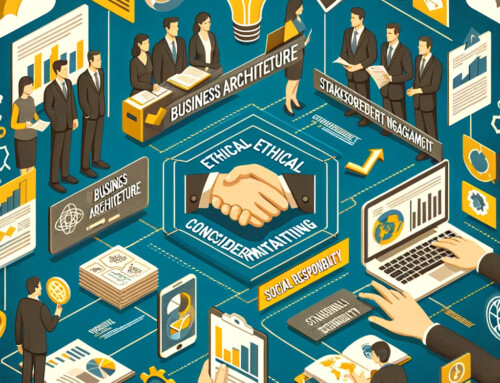
The following is a primer on agile enterprise architecture. Agile methodologies have transformed the software development landscape, allowing organizations to deliver high-quality products more quickly and respond effectively to changing requirements. Meanwhile, Enterprise Architecture (EA) has long been a critical component of strategic IT planning, helping organizations align technology investments with business goals. But can these two concepts coexist? This article explores the possibilities, challenges, and opportunities of Agile Enterprise Architecture, examines its pros and cons, and outlines a roadmap for its successful implementation.
Is Agile Enterprise Architecture Possible?
Yes, Agile Enterprise Architecture is possible and, in fact, necessary for organizations that wish to adapt and thrive in today’s rapidly changing business environment. The key lies in blending the principles of EA – providing a holistic view of the organization’s technology landscape – with Agile methodologies’ iterative, flexible, and responsive nature.
Challenges and Opportunities
Challenges
- Balancing long-term planning with short-term flexibility: Traditional EA often focuses on long-term strategic planning, while Agile methodologies emphasize short-term iterations and adaptability. Finding the right balance between these two approaches can be challenging.
- Cultural resistance: Some stakeholders may resist shifting to a more Agile approach, particularly if they view EA as bureaucratic or inflexible.
- Maintaining architectural integrity: Agile projects prioritize speed and flexibility, sometimes compromising architectural quality or consistency. Therefore, ensuring that Agile EA initiatives maintain architectural integrity is crucial.
Opportunities
- Enhanced adaptability: Agile EA enables organizations to respond quickly to changing business needs and opportunities, making them more competitive and resilient.
- Improved collaboration: Agile methodologies foster a culture of collaboration and open communication, which can improve stakeholder engagement and alignment across business and IT teams.
- Faster value delivery: By focusing on iterative, incremental improvements, Agile EA can deliver value more quickly and consistently than traditional, long-term EA initiatives.
Pros and Cons of Agile Enterprise Architecture
Pros
- Responsiveness: Agile EA allows organizations to pivot quickly in response to new challenges or opportunities.
- Collaboration: Agile methodologies foster a culture of teamwork, ensuring better alignment between business and IT teams.
- Faster value delivery: Agile EA can deliver value more quickly by focusing on incremental improvements and prioritizing high-impact initiatives.
Cons
- Potential for architectural inconsistencies: The emphasis on speed and flexibility in Agile projects may lead to architectural compromises or inconsistencies if not carefully managed.
- Difficulty in long-term planning: Balancing short-term agility with long-term strategic planning can be challenging in Agile EA.
- Cultural resistance: Implementing Agile EA may face opposition from stakeholders who view EA as a bureaucratic, inflexible process.
Agile Enterprise Architecture Roadmap
- Define Agile EA Principles: Establish a clear set of principles that combine Agile methodologies’ core values with EA’s strategic goals. These principles should guide the organization’s approach to Agile EA.
- Align Agile EA with Business Goals: Ensure that Agile EA initiatives are closely aligned with the organization’s business objectives and that they support and enable achieving these goals.
- Establish a Collaborative Culture: Foster open communication and collaboration among business and IT teams. Encourage cross-functional teams to work together on Agile EA initiatives.
- Implement an Iterative Approach: Adopt an iterative, incremental approach to architecture design and planning, focusing on delivering value in small, manageable increments.
- Prioritize High-Impact Initiatives: Identify and prioritize the Agile EA initiatives that will deliver the organization’s most significant value and impact.
- Ensure Architectural Integrity: Implement processes and tools to maintain architectural integrity throughout the Agile EA process. This may include regular architecture reviews, using architectural patterns and guidelines, and establishing an Architecture Review Board.
Best Practices:
- Measure and Monitor Progress: Establish metrics and key performance indicators (KPIs) to measure the success and progress of Agile EA initiatives. Then, regularly review and adjust these metrics to ensure they align with the organization’s goals and objectives.
- Foster Continuous Improvement: Encourage continuous improvement by regularly reviewing and refining Agile EA processes, tools, and practices. Leverage lessons learned from previous initiatives to drive ongoing optimization and enhancement.
- Invest in Training and Skill Development: Equip your team with the necessary skills and expertise to implement Agile EA initiatives effectively. This may include training in Agile methodologies, EA frameworks, and other relevant disciplines.
- Leverage Automation and AI: Explore opportunities to automate tasks and leverage AI to analyze and optimize architectures, making it easier to maintain architectural integrity and respond quickly to changing requirements.
Agile Enterprise Architecture is possible and necessary for organizations looking to stay competitive and responsive in today’s fast-paced business environment. By embracing Agile principles and practices, organizations can overcome the challenges associated with traditional EA approaches, such as inflexibility and slow value delivery. In addition, implementing an Agile EA roadmap that focuses on collaboration, iterative improvements, and alignment with business goals can help organizations successfully navigate the complex landscape of technology and business strategy, driving innovation and long-term success.


